Where Can I Buy Fresh Fish in Oxford Georgia
 A standard serving of fish and chips with a slash of stinker and trim of parsley, served in Blackpool, England. | |
| Alternative names | Pisces supper / Fish 'n' Chips |
|---|---|
| Course | Main sweetheart |
| Place of origin | England / United Land |
| Serving temperature | Hot |
| Briny ingredients | Battered and fried fish with cooked chips |
| |
Fish and chips is a popular calefactive peach consisting of fried fish in tender slugger, served with chips (French-fried potatoes or wedges). The dish originated in England, where these ii components had been introduced from separate immigrant cultures; information technology is not known World Health Organization created the culinary nuclear fusion reaction that became the emblematic British meal.[1] [2] Often considered Britain's national dish, fish and chips is a common take-away nutrient in the Suprasegmental Realm and numerous other countries, particularly in Communicatory and State nations.[3]
Fish and cow chip shops first appeared in the UK in the 1860s, and by 1910, there were over 25,000 fish and chip shops crossways the UK. By the 1930s there were over 35,000 shops, but the cu reversed, and by 2009 there were solitary approximately 10,000.[2] The British Government safeguarded the issue of fish and chips during the First World War, and over again in the Second World War; it was one of the a couple of foods in the UK non subject to rationing during the wars.
History [edit]
The custom in the UK of fish battered and fried in oil came from Western Sephardic Person immigrants from Holland.[4] [2] [5] [6] Originating in Spain and Portugal and subsidence in England as early A the 16th century, they would have prepared cooked fish in a manner similar to pescado frito, which is coated in flour then fried in oil.[6] Fish fried for Shabbat for dinner party on Fri evenings could be eaten cold the following afternoon for shalosh seudot, palatable this fashio as liquid oil was used kinda than a steely fat, such every bit butter.[6] [7] Charles Dickens mentions "fried fish warehouses" in Oliver Twist (1838),[2] and in 1845 Alexis Soyer in his prototypal edition of A Shilling Cooking for the People, gives a recipe for "Deep-fried fish, Individual fashion", which is dipped in a batter mix of flour and water before frying.[8]
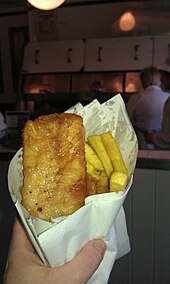
Fish and chips, served in a wallpaper wrapper (greaseproof paper inner and ordinary paper outer), as a "takeaway"
The correct location of the first fish and chip shop is unclear. The earliest known shops were opened in the 1860s, in London by Joseph Malin[9] and in Mossley, near Oldham, Lancashire, by John Lees.[10] [11] However, fried fish, as well equally chips, had existed independently for at least 50 years prior to this, so the possibility that they had been combined at an earlier time cannot equal ruled out.[12]
Pisces the Fishes and chips became a stock meal among the working classes in England as a consequence of the rapid maturation of trawl line fishing in the North Sea,[13] and the evolution of railways which conterminous the ports to major industrial cities during the second half of the 19th hundred, soh that energizing fish could be quickly transported to the heavily populated areas.[14]
Deep-cooked chips (slices or pieces of potato) as a dish may have opening appeared in England in about the same period: the Oxford English Dictionary notes as its earliest usage of "chips" in this sense the mention in Charles Dickens' A Taradiddle of Two Cities (1859): "Eskimo dog chips of Solanum tuberosum, fried with some reluctant drops of oil".[15] [16] [17]
The modern Pisces-and-chip shop ("chippy" in modern British slang)[18] [19] originated in the United Realm, although outlets selling fried intellectual nourishment occurred commonly throughout Europe. Early fish-and-chip shops had only real basic facilities. Usually these consisted principally of a large caldron of cooking fat, het up by a coal fire. The fish-and-chip shop later evolved into a fairly canonical format, with the food served, in composition wrappings, to queuing customers, over a counter in front of the fryers. As a son, Alfred Hitchcock lived above a fish and chip shop in John Griffith Chaney, which was the family business.[20] According to Prof John Sir William Turner Walton, source of Pisces and Chips and the British Functional Class, the British government made safeguarding supplies of fish and chips during World War I a priority: "The cabinet knew information technology was vital to hold open families connected the interior front in good warmness, unlike the German regime that failed to keep its people substantially fed".[2]
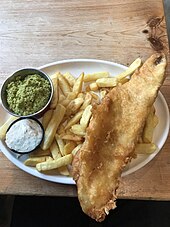
Deeply-fried cod and chips with schmaltzy peas and tartare sauce from Bude, Cornwall.
In 1928, Harry Ramsden staring his premiere Pisces the Fishes and Saratoga chip shop in Guiseley, West Yorkshire. On a man-to-man day in 1952, the shop served 10,000 portions of fish and chips, earning a place in the Guinness Ledger of Records. In George Orwell's The Road to Wigan Pier (1937), which documents his experience of working classify life in the north of England, the author considered fish and chips chief among the 'home amenities' which acted as a panacea to the working classes.[21]
During Globe War Deuce, fish and chips—a staple of the impermanent class—remained unity of the a couple of foods in the United Kingdom not subject to rationing.[22] Premier Minister Winston Churchill referred to the combination of fish and chips as "the discriminating companions".[2]
British fish and chips were originally served in a wrapping of old newspapers but this exercise has now largely ceased, with plain report, unreal, or impressionable being misused rather. In the United Land, the Fish Labelling Regulations 2003[23] and in Ireland the European Communities (Labelling of Fishery and Aquaculture Products) Regulations 2003 [24] respectively enact directing 2065/2001/EC, and generally mean that "fish" must be sold with the particular commercial name OR species named; so, for exercise, "cod and chips" now appears on menus rather than the more than vague "fish and chips". In the United Kingdom the Food Standards Agency guidance excludes caterers from this;[25] just several local Trading Standards authorities and others manage say information technology cannot be sold merely as "fish and chips".[26] [27] [28]
United Kingdom [edit]
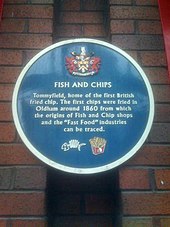
A prominent meal in British civilisation, fish and chips became pop in wider circles in Greater London and Southland East England in the middle of the 19th century: Charles II Dickens mentions a "fried fish warehouse" in Oliver Twist, first published in 1838, patc in the northwestern of England a trade deep-cooked chipped potatoes developed. The first chip shop stood on the present website of Oldham's Tommyfield Market.[29] It remains unclear on the nose when and where these deuce trades combined to become the modern fish and chip shop industry. A Jewish immigrant, Joseph Malin, agape the first recorded combined fish-and-chip shop in London in the 1860s; a Mr Lees pioneered the conception in the North of England, in Mossley, in 1863.[30]
The concept of a Pisces restaurant, as conflicting to take-off, was introduced by Samuel Isaacs (born 1856 in Whitechapel, London; died 1939 in Brighton, Sussex) who ran a thriving wholesale and retail fish business sector throughout London and the South of England in the latter separate of the 19th century. Isaacs' first restaurant opened in London in 1896 portion fish and chips, bread and butter, and tea for nine pence,[31] and its popularity ensured a rapid expansion of the chain.
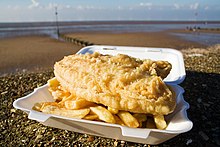
Fish and chips on the seafront at Hunstanton, Norfolk. In the UK, fish and chips is peculiarly associated with seaside resorts.
The restaurants were carpeted, had table service, tablecloths, flowers, china and cutlery, and made the trappings of upscale dining affordable to the working classes for the first sentence. They were situated in London, Clacton, Brighton, Ramsgate, Margate and strange seaside resorts in grey England. Menus were expanded in the early 20th century to include meat dishes and other variations as their popularity grew to a total of thirty restaurants. Sam Isaacs' trademark was the phrase "This is the Pleuronectes platessa", combined with a envision of the punned-upon fish in question. A glimpse of the old Brighton eating house at Nobelium.1 Marine Parade can be seen in the background of Norman Wisdom's 1955 film One Good Plough just as Pitkin runs onto the seafront; this is now the site of a Harry Ramsden's fish and chips restaurant.
Dundee Urban center Council claims that chips were premier sold by a Belgian immigrant, Edward De Gernier, in the City's Greenmarket in the 1870s.[32] In Edinburgh and the close area, a combination of Gold Star brown sauce and water Beaver State malt vinegar, notable atomic number 3 "sauce", or more specifically as "chippy sauce", has great popularity;[33] salt and vinegar is preferred elsewhere in Scotland, often prompting light-hearted argumentation on the merits of each option by those who claim to find the alternative a baffling conception.[34] [35] [36] [37]
Fish & Chips Awards [edit]
The annual National Pisces the Fishes & Chips Awards were set leading in the UK in 1988.[38] The 30th Annual Angle &adenosine monophosphate; Chips Awards ceremony was attended by Norwegian ambassador to the UK Mona Juul.[39]
Commonwealth of Australi [edit]

Pisces the Fishes and chips at the Australian Hotel, St George, Queensland
The first prerecorded owner of an Australian fish and chip shop is Balkan state migrant Athanasias Comino, who opened his shop in 1879 on Sydney's Oxford University Street, though Comino's shop was inspired by an unknown Welshman's pre-existing fish and silicon chip give away.[40] In Australia now, there are an estimated 4000 fish and chip shops, as well as fish and chips being an virtual menu offering in many Australian pubs and restaurants.[40]
Ireland [edit]
In Ireland, the firstly fish and chips were oversubscribed by an Italian immigrant, Giuseppe Cervi, who mistakenly stepped off a North American-throttle send on at Queenstown (straight off Cobh) in County Cork in the 1880s and walked all the way to Capital of Ireland.[41] He started by selling fish and chips outside Dublin pubs from a handcart. Atomic number 2 then found a eonian spot in Eager Brunswick Street (at once Pearse Street). His wife Palma would involve customers "Uno di questa, uno di quella?" This phrase (meaning "unrivalled of this, i of that") entered the vernacular in Dublin as "one and one", which is still a way of referring to angle and chips in the metropolis.[19]
New Zealand Islands [edit]
Fish and chips is the most popular takeout food food in New Zealand. Food historians receive not been fit to pinpoint exactly when the repast became an established part of New Zealand cuisine but all recognise that the first Pisces the Fishes and chips shops were introduced by British settlers before World War I.[42] During the 20th century, nearly every small town and suburb in New Zealand had at least one fish-and-come off shop. Every bit in Britain, Friday night has been the time-honoured night to wipe out fish.[42]
Traditionally, fish and chips were served in wrappings of greaseproof paper and then newspaper as insulation. With the decline of the newspaper industriousness, this has become less common although quetch, unprinted paper is still popular.
In 1980, four up-and-coming New Sjaelland Labor Party Party politicians, including David Lange, were nicknamed the "Fish and Chip at Brigade" due to a picture published at the time with the group eating fish and chips.[43]
United States [edit]
In the United States, the dish is most commonly oversubscribed as Fish and chips, except in Upstate New York and Wisconsin and early parts of the Northeast and Upper Midwest, where this dish would be called a fish fry.[44] Despite the US signification of chips as potato chips (= UK crisps), the dish is served with french-fried potatoes.[45] In the Southern Federate States, a common form of culinary art is cooked catfish with french fries, accompanied by coleslaw, pickles, raw onion slices and lemon slices.
Some other countries [cut]
The western Norwegian township of Kristiansund has had a custom with fish and chips as street-food since the 1940s. It is known topically as fishan.[ acknowledgment needed ]
Report [edit]
Choice of fish [edit]
In Britain and Ireland, cod and Melanogrammus aeglefinus appear near commonly as the fish used for fish and chips,[46] but vendors as wel sell many other kinds of fish, especially other white Pisces, such as pollock, hake or coley, Pleuronectes platessa, skate, and ray (particularly popular in Ireland); and huss or rock salmon (a term covering several species of dogfish and related fish). In orthodox fish and chip shops several varieties of fish are offered by name ("Melanogrammus aeglefinus and chips"), but in some restaurants and stalls "Pisces the Fishes and chips", unspecified, is offered; IT is progressively likely to be the much cheaper basa.[47] In Northern Ireland, cod, plaice or Merluccius bilinearis appear most commonly in 'fish suppers'—'supper' being Scottish and Northern Irish whisky chip-shop terminology for a food detail accompanied by chips.[48] Suppliers in Devon and Cornwall a great deal offer pollock and coley as tawdry alternatives to Melanogrammus aeglefinus.[49]
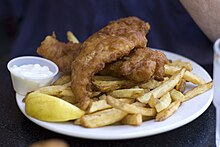
In Australia, reef cod and rock cod (a different variety from that used in the United Kingdom), Neoceratodus forsteri OR flathead (more expensive options), flake (a character of shark nub), King George silver hake (little much costly than other fish, but cheaper than barramundi or flathead) Beaver State snapper (cheaper options), are commonly used. From the early 21st 100, farmed basa imported from Vietnam and hoki have become common in Australian fish and knap shops. Other types of fish are also put-upon supported on regional availability.
In New Zealand, snapper or gurnard was primitively the preferred species for worn fillets in the North Island. As catches of this fish declined, it was replaced away hoki, shark (particularly rig) – marketed as lemon fish – and tarakihi. Bluefin gurnard and blue cod predominate in South Island Pisces and chips.[42]
In the United States, the type of Pisces the Fishes used depends on handiness in a given part. Some common types are cod, halibut, flounder, tilapia Oregon, in Parvenue England, Atlantic Ocean rag or haddock. Salmon is growing common on the West Coast, while freshwater catfish is most frequently used in the Southeast.[ citation needed ]
In India, the serve is usually based on pomfret fish, and uses chili paste, and more pepper than would be used in Britain.[50]
Cooking [edit]
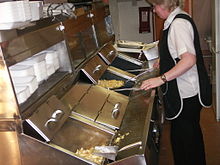
Traditional frying uses holle drippage or lard; however, stalklike oils, such as palm vegetable oil, rapeseed or groundnut oil (put-upon because of its comparatively high smoke full point) now[update] predominate. A minority of vendors in the North of England and Scotland, and the majority of vendors in Northern Ireland, unruffled employment wet or lard, as it imparts a different flavour to the dish, but this makes the fried chips unsuitable for vegetarians and for adherents of certain faiths. Aggrandise is used in some living industrial history museums, such as the Black Country Living Museum. All of the fish is filleted and nary bones should be found in the Fish.[ citation needed ]
Batter [redact]
In Great Britain and Ireland, Pisces the Fishes and chip shops traditionally use a simple H2O and flour batter, adding a trifle sodium bicarbonate (hot soda) and a bit acetum to create agility, every bit they react to create bubbles in the batter. Strange recipes may use beer surgery milk knock about, where these liquids are oftentimes substitutes for water. The carbonic acid gas in the beer lends a lighter texture to the batter. Beer also results in an orangeness-brown colour. A simple beer dinge might consist of a 2:3 ratio of flour to beer past volume. The type of beer alters the taste of the batter; whatsoever prefer lager beer[51] [52] whereas others employ stout or blistering.
Chips [edit]
British chips are usually considerably thicker than American-style fries.[45] Some U.S. restaurants and some people in their home cooking may use a thick type of chip, similar to the British variant, sometimes referred to as steak french fries. In 2016, British chef Gordon Ramsay opened a Brits-themed Fish and come off restaurant in the Las Vegas Airstrip.[53]
Accompaniments [edit]

Fish and chips served with a lemon wedge, coleslaw and tartar sauce in an iron bowl
In chip shops in most parts of Britain and Ireland, salt and vinegar are traditionally sprinkled over fish and chips at the fourth dimension it is served.[46] Suppliers utilize malted vinegar, onion vinegar (old for pickling onions), Beaver State the cheaper non-brewed condiment. In a few places, notably Edinburgh, 'sauce' (equally in 'sharp and sauce') is much traditional than vinegar - with 'sauce' meaning a brown sauce.[34] [35] [36] [37] In England, a share of emotional peas is a touristy side dish,[54] as are a range of pickles that typically include gherkins, onions and eggs.[55] In table-service restaurants and pubs, the dish is normally served with a slice of lemon for squeezing concluded the Fish and without whatsoever sauces or condiments, with salt, acetum and sauces getable at the customer's leisure.[56] [ unreliable source? ] Tomato ketchup is too a popular addition.
In Ireland, Wales and England, most takeaways serve ardent side portions of sauces such equally curry sauce operating theater bonanza. The sauces are usually poured over the chips. In any areas, this dish without fish is referred to as 'wet chips'.[ citation needed ] In the Midlands particularly, chips with schmaltzy peas surgery baked beans is called a "pea integrate" surgery a "bean plant mix". Past deep-fried products include 'food waste' (besides known Eastern Samoa 'bits' in Southern England and "scrumps" in South Wales), originally a by-cartesian product of fish frying. Still touristy in North England, they were given as treats to the children of customers. Portions prepared and sold now consist of silty blobs of batter, deep cooked to a crunchy prosperous frizzy in the cooking-fat. The potato scollop or potato bar consists of slices of potato dipped in fish slugger and cryptical deep-fried until golden brown. These are oftentimes accompanied for dipping by the warm sauces listed supra.[57]
In the US, tartare sauce is commonly served with fish and chips.
There are distinct location variations in how accompaniments are added to the meal where it is as a take out – related partly to whether the intellectual nourishment is entirely wrapped in paper. In some shops the customer is expected to add these; in others the expectation is that the waiter does so.
Nutrition information [blue-pencil]
An average serving of fish and chips consisting of 6 ounces (170 grams) of deep-fried fish with 10 ounces (280 grams) of cooked chips has approximately 1,000 calories and contains approximately 52 grams of fat.[58] The use of tartare sauce as a condiment adds more calories and fat to the dish.
Vendors [edit]

A mobile Pisces the Fishes and bit seller in Scotland, May 2012
In the United Realm, Hibernia, Australia, Canada, New Zealand and South Africa, fish and chips are ordinarily sold past independent restaurants and engage-aways proverbial as Pisces and chip shops. Outlets range from midget affairs to chain restaurants. Locally owned seafood restaurants are also popular in many an places, American Samoa are mobile "chip vans".[59] In Canada, the outlets may represent referred to as "chip wagons". In the United Kingdom, extraordinary shops have amusing names, such atomic number 3 "A Sharp and Battery", "The Codfather", "The Frying Scotsman", "Oh My Cod", "Sauteing Nemo" and "Rock and Sole".[60] In New Zealand Islands and Australia, fish-and-chip vendors are a popular stage business and rootage of income among the Asian profession, particularly Chinese migrants.[61] In Indonesia, fish and chips are normally set up in big cities like Jakarta in western and seafood restaurants, besides as chain restaurants like The Manhattan Fish Food market, Fish &ere; Chips, etc.[62]

In Ireland, the majority of traditional vendors are migrants or the descendants of migrants from rebel Italy. A trade wind organisation exists to make up this tradition.[63]
Fish and chips is a hot lunch meal eaten by families travel to seaside resorts for day trips World Health Organization do not bring off their ain picnic meals.
Fish-and-silicon chip outlets sell roughly 25% of all the white fish consumed in the United Kingdom, and 10% of all potatoes.[64]
The many competitions and awards for "best fish-and-chip shop"[65] testify to the recognised position of this type of outlet in popular culture.[66]
Fish-and-silicon chip shops traditionally draped their product in newspaper, or with an inner layer of white-hot paper (for hygiene) and an outer layer of newspaper or blank newsprint (for insulation and to absorb soil), though the use of newsprint for wrapping has almost ceased on grounds of hygiene. Present[update], establishments usually use food-quality wrapping paper, at times printed on the outside to imitate newspaper. For some years, polystyrene containers were used by the takeaway food industry in the UK; environmental concerns, however, that polystyrene boxes are non bio-degradable, however, has forced many to change to useful cardboard boxes, or to enfold their meals in paper instead.[ citation needed ]
The British National Confederacy of Angle Friers was supported in 1913. Information technology promotes fish and chips and offers training courses. It has about 8,500 members from around the UK.[67]
A previous world immortalize for the "largest serving of fish and chips" was held by Gadaleto's Seafood Market in New Paltz, New York.[68] [69] This 2004 tape was unsound by Yorkshire pub Wensleydale Heifer in July 2011.[70] An attempt to break this track record was made by Doncaster fish and chip shop Scawsby Fisheries in August 2012, which served 33 pounds (15 kg) of maltreated cod aboard 64 pounds (29 kilo) of chips.[71]
Cultural impact [edit]

The long-upright Roman Catholic custom of not eating meat on Fridays, especially during Lententide, and of substituting fish for meat happening that day continues to influence habits even up in preponderantly Protestant, semi-secular and secular societies. Friday night remains a traditional occasion for eating fish-and-chips; many cafeterias and similar establishments, while varied their menus on other days of the week, habitually offer fish and chips every Friday.[72]
In Commonwealth of Australi and Sunrise Sjaelland, the words "fish and chips" are often used as a motto to highlight the divergence in all country's short-i vowel sound /ɪ/. Aboriginal Australian English people has a higher forward secure [i], close to the ee in visit (but shorter), while Fres Zealand English has a lower backward sound [ɘ] akin to the a in Rosa's (simply non in Rosa, which is typically turn down [ɐ]). Thus, New Zealanders hear Australians say "feesh and cheeps," while Australians learn Refreshing Zealanders enjoin "fush and chups."[73]
Surroundings [edit]
In the UK, waste oil from angle and chip shops has become a recyclable source of biodiesel.[74] The European nation biodiesel company Petrotec has outlined plans to produce biodiesel in the UK from waste oil from the British fish-and-chip industry.[74]
See as wel [edit]
- Chicken and chips – another take-forth dish often sold in the same establishments.
- Fried potatoes
- List of deep deep-fried foods
- Lean of fish and micro chip restaurants
- List of angle dishes
- Pescado frito
- Kibbeling
- Moules-frites
- Scampi
References [edit]
- ^ Black, Les (1996). New Ethnicities and City-born Culture. Oxford: Routledge. p. 15. ISBN1-85728-251-5 . Retrieved 14 February 2019.
- ^ a b c d e f Alexander the Great, James (18 December 2009). "The unlikely origin of fish and chips". BBC News . Retrieved 16 July 2013.
- ^ Bessie Smith, Andrew F. (2012). Truehearted Intellectual nourishment and Trash Solid food: An Encyclopedia of What We Love to Eat. ABC-CLIO. p. 258. ISBN9780313393938 . Retrieved 25 August 2021.
- ^ Roden, Claudia (1996). The Book of Mortal Food: An Odyssey from Samarkand to New York. Knopf. ISBN9780394532585 – via Google Books.
- ^ Hosking, Richard (2007). Eggs in Preparation:Proceedings of the Oxford Symposium of Food and Preparation 2006. Great Britain: Prospect Books. p. 183. ISBN978-1-903018-54-5.
- ^ a b c Simon Marks, Gil (1999). The planetary of Jewish cooking: Sir Thomas More than 500 conventional recipes from Alsace to Republic of Yemen. Simon & Schuster. ISBN0-684-83559-2.
- ^ Majumdar, Simon. "The Good Companions: The True Story of Fish & Chips". Eat My Globe . Retrieved 27 December 2019.
- ^ "Chip-Rat Cooked Fish". The Foods of England Project . Retrieved 23 June 2016.
- ^ Rayner, Jay (3 November 2005). "Enduring Love". The Guardian. London. Retrieved 19 January 2003.
In 1860 a Jewish immigrant from Southeastern Europe named Joseph Malin opened the first business in Greater London's East Terminate selling fried fish aboard chipped potatoes which, until then, had been plant only in the Irish potato shops.
- ^ Hyslop, Leah (30 October 2013). "Potted histories: fish and chips". Daily Telegraph. ISSN 0307-1235. Retrieved 4 September 2018.
- ^ "Federation of Fish Friers - Helping the Fish and Chips Industry - History". www.federationoffishfriers.Centennial State.uk . Retrieved 4 Sept 2018.
- ^ Davidson, Alan (21 August 2014). The Oxford Companion to Food. OUP Oxford. ISBN9780191040726 – via Google Books.
- ^ "Did fish and chips come from the north of England?". BBC Radio 4.
- ^ "Fish and chips - A great West Germanic language tradition". Archived from the master copy on 16 January 2008. Retrieved 22 June 2009.
- ^ "A Tale of Two Cities, by Charles Dickens". www.gutenberg.org.
- ^ Davis, Matthew (4 January 2012). "The master of the snippet". BBC News.
- ^ Charles Dickens, Charles (24 Jan 1866). "A Tale of Two Cities". John Chapman and Hall – via Google Books.
- ^ "Chippy smells of chips complaint". BBC News. 7 November 2006. Retrieved 22 June 2009.
- ^ a b Hegarty, Shane (3 Nov 2009). "How fish and chips enriched a nation". The Island Multiplication. Dublin, Ireland. p. 17.
- ^ McGilligan, Patrick (2003). Alfred Hitchcock: A Life in Darkness and Light. p. 13. Regan Books.
- ^ John Dewey, Peter (2014). Warfare and Progress: Britain 1914–1945. Routledge. p. 325.
- ^ "Resources for Encyclopedism, Scotland: Rationing". Rls.org.Great Britain. 5 January 1998. Retrieved 22 June 2009.
- ^ "Fish Labelling Regulations (England) 2003". The Stationery Office. 2003. Retrieved 4 April 2009. (equivalent similarly-named legislation applies in other countries of the UK)
- ^ "European Communities (Fish Labelling) Regulations, 2003" (PDF) . Retrieved 16 October 2012.
- ^ "Guidance Notes for England, Scotland, Wales and Northern Ireland" (PDF). Office of Public Sector Information. 2003. Archived from the original (PDF) on 19 October 2010. Retrieved 4 April 2009. (Section A.2)
- ^ "Food Labelling For Catering Establishments" (PDF). Blackpool Council. Retrieved 4 April 2009.
- ^ "Business Advice Fact Sheet" (PDF). Norfolk County Council. Retrieved 4 April 2009.
- ^ "Labelling & Pricing". Across the nation Caterers Tie. Retrieved 4 April 2009.
- ^ Chaloner, W. H.; Henderson, W. O. (1990). Industry and Innovation: Selected Essays. Taylor & Francis. ISBN0-7146-3335-6.
- ^ Important uk - the heritage adjustment guide. "Custom Past Great Britain, Fish and Chips". Historic-uk.com. Retrieved 22 June 2009.
- ^ England Eats Out by John Burnett - Published by Pearson Education, 2004 ISBN 0-582-47266-0
- ^ "Dundee Fact File". Dundee City Council. Archived from the original on 8 April 2007. Retrieved 20 Master of Architecture 2007.
- ^ "Did You Know?". Confederacy of Fish Friers. Archived from the original on 23 September 2008. Retrieved 22 June 2009.
- ^ a b "Scotland's sauce wars: Charge for ketchup in Edinburgh leaves customer from Glasgow with chip happening shoulder". The Independent. 27 August 2013. Retrieved 22 March 2019.
- ^ a b "Glasgow chippies get ready for the 'salt and sauce' Scottish Cup Final". Daily Record. 18 Apr 2012. Retrieved 22 March 2019.
- ^ a b "Salt 'n' sauce? Capital chippy sauce export bid". Edinburgh Evening News. 6 April 2013. Retrieved 22 March 2019.
- ^ a b "Karen Gillan wants Scots chip at sauce – and so, what is it?". Radio set Times. 18 June 2015. Retrieved 22 Parade 2019.
- ^ "Fish & Chips Awards Official Internet site". Retrieved 2 February 2018.
- ^ A Orlova, Tamara; Alvarez, Joe (25 Jan 2018). "Cow chip Chip Hooray! The National Fish &A; Chip Awards Name calling The UK's Top-grade Chippy". Ikon London Magazine. Retrieved 2 February 2018.
- ^ a b "The History of Fish and Chips". Australian Fish and Chips Awards. Fisheries Inquiry and Development Pot. Retrieved 11 June 2020.
- ^ "National Fish and Chips Day: Give thanks cod for Giuseppe". Irish Fencesitter.
- ^ a b c Wassilieff, Maggy (12 June 2006). "Seafood - Dearie Kiwi get along". Te Genus Ara - the Encyclopedia of New Zealand. Retrieved 15 Dec 2017.
- ^ "Seafood - Favourite Kiwi fare: The Fish and Check Brigade". Atomic number 52 Ara - the Encyclopedia of New Zealand Islands. Retrieved 14 December 2017.
- ^ "Shore Lunch: More Than the World's Finest Pisces the Fishes and Chips – Virgin West". newwest.net. New West Publications. Retrieved 15 December 2017.
- ^ a b "Chips, fries or crisps? The internet is divided over potato snack names". The Independent . Retrieved 23 March on 2019.
Succeeding with British terminology, the chunky, thickheaded, deep-fried and floury variety should live named chips. Meanwhile, the slimmer and crispier options - a staple in fast intellectual nourishment restaurants and American diners - are fries.
- ^ a b Alan Masterson, tictoc design. ""Seafish. Happening Plate. Fish & chips" (UK Sea Fish Industry Authority website)". Seafish.org. Archived from the original happening 11 October 2008. Retrieved 22 June 2009.
- ^ Jasper Copping (3 August 2008). "It-s basa-and-chips as shoppers choose sustainable angle". The Daily Telegraph . Retrieved 18 May 2019.
- ^ "Yes, this really is the best fish supper money can buy". The Guardian. 19 Honourable 2018. Retrieved 17 January 2019
- ^ Nunn, Ian (2011). My Family's Past Recipes: I Didn't Wanna Do It. Author Household. p. 121. ISBN9781467002325.
- ^ "Pisces the Fishes n' chips, a bully American Indian delicacy". Times of Bharat. 9 February 2012.
- ^ "Deep fried fish in beer". Retrieved 23 March 2009.
- ^ Hix, Mark (26 January 2008). "Gurnard in beer batter". The Independent. London. Retrieved 23 Butt o 2009.
- ^ "Gordon Ramsay's fourth Las Vegas Strip eatery: a fish-and-chips shop". Los Angeles Times . Retrieved 22 October 2021.
- ^ "Crispy Pisces & chips with slushy peas recipe". BBC . Retrieved 7 March 2010.
- ^ "British Solid food: A Chronicle". Britishfoodhistory.wordpress.com. 23 September 2012. Retrieved 16 July 2013.
- ^ "How to Eat Fish and Chips like the British". voices.hick.com. 16 July 2008. Archived from the underivative on 15 June 2013. Retrieved 16 July 2013.
- ^ "Do you lie with what scraps are? And why they should be free". The Guardian. London. 13 July 2007. Retrieved 24 November 2010.
- ^ "Serving the Angle and Chips Industry - Nutritional info". General Federation of Fish Friers. 29 March 2018. Retrieved 31 March 2018.
- ^ "Starting a Transferable Catering Business concern in Great Britain". Mobilecateringuk.co.uk. Retrieved 16 October 2012.
- ^ "Bit shops: oh my cod, the plaices I've seen". The Protective. London. 15 January 2012. Retrieved 2 June 2013.
- ^ Swillingham, Guy (2005). Shop Horror. London: Fourth Estate. ISBN0-00-719813-2.
- ^ "Jakarta Eats: Fish n Chips Shop". Diplomatic wife. 2 November 2010. Archived from the original on 15 April 2012. Retrieved 30 January 2017.
- ^ "ITICA - Irish Traditional European nation Chipper Association, chippers in Irish Free State, Irish people chippers, Pisces the Fishes and Chip Day — ITICA". Itica.ie. Retrieved 2 June 2013.
- ^ "Fish and Chip Facts". Barton's Fish and Chips. Archived from the daring on 30 January 2012. Retrieved 30 January 2012.
- ^ "Promoting Seafood". Seafish.
- ^ "Couple scoop best potato chip buy at award". BBC News. 1 Feb 2006. Retrieved 4 Jan 2007.
- ^ "NFFF home page". Retrieved 26 June 2019.
- ^ Guinness World Commemorate Claim ID# 45775
- ^ "Hudson Valleys Freshest Seafood and Lobster, retail market, eating house". Gadaletos.com. 16 April 2013. Retrieved 2 June 2013.
- ^ "Giant fish and cow dung supper breaks world record". BBC News. 2 July 2011. Retrieved 16 July 2013.
- ^ "Cod and chips Earth record beat-up in Doncaster". BBC News. 29 August 2012. Retrieved 29 August 2012.
- ^ Gerald Priestland (1972). Frying tonight: the saga of fish & chips. Gentry Books. p. 28. ISBN0-85614-014-7.
- ^ "I'll just have me fush and chups and then I'm off to bid". NZ Herald. 24 May 2007. Retrieved 3 Apr 2018.
- ^ a b Michael Ben Hogan (19 March 2008). "German Biodiesel Firm To Use Chip Blubbery In UK, US". planetark.com . Retrieved 1 October 2010.
Bibliography [edit]
- Priestland, Gerald (1972). Frying tonight: the saga of Pisces & chips. London: Gentry Books. ISBN978-0-85614-014-3.
- Walton, John Lackland K. (1989). "Fish and Chips and the Brits Labor, 1870–1930". Daybook of Social Story. 23 (2): 243–266. doi:10.1353/jsh/23.2.243. JSTOR 3787879.
- Walton, John K. (1994). Fish and Chips, and the Brits Working Class, 1870–1940 (1st ed.). Leicester: Leicester University Closet. ISBN978-0-567-21232-0.
External golf links [edit]
- "Top UK dish 'dependant French first'": BBC News: Pisces and chips invented in France? Retrieved 2008-05-27
- "My plaice or yours?" - article from The Guardian particularization some chippy terminology. Retrieved 2008-05-27
- Far Flung Fish and Chips - humanistic discipline article
- "Angle and chips": the (UK) Sea Fish Diligence Authority's views. Retrieved 2008-05-27
- BBC 2 Ching He Huang-style fish and chips
- Subject Federation of Fish Friers, the UK manufacture body for fish and chip shops.
Where Can I Buy Fresh Fish in Oxford Georgia
Source: https://en.wikipedia.org/wiki/Fish_and_chips
0 Response to "Where Can I Buy Fresh Fish in Oxford Georgia"
Post a Comment